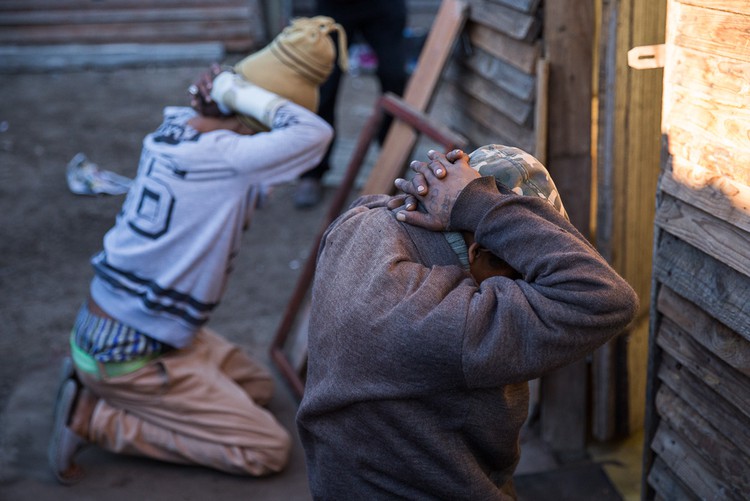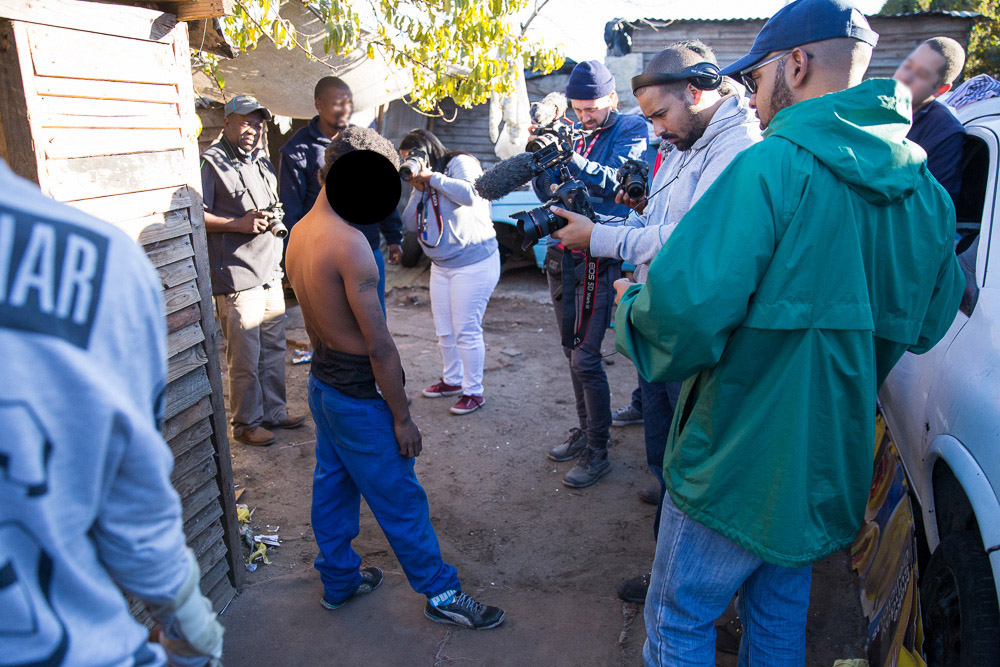The moral dilemmas of embedded journalism
I was excited to go on a police ride-along but by the end of it I wondered if I’d compromised my ethics
On Monday, journalists were invited to ride along on a crime operation with the Cape Town Metro Police Department and the Gang and Drug Task Team.
In my ignorance, I believed that there are certain things one needs to experience to be a great photojournalist. Being relatively young in the industry, I want to be part of the pack. I’ve already been shot with rubber bullets, tear-gassed and threatened with arrest. Witnessing a dangerous drug raid would be one more decoration and another step to Twitter fame.
We met in Parow, where we signed our indemnity forms and were briefed by Metro Police Chief Wayne Le Roux. He gave us a basic overview of the operation and told us to avoid showing the faces of police officers as some of them live and work in the areas where the operation was taking place.
We were taken in a police van on a five-minute drive to Leonsdale, Elsies River. Arriving in a police vehicle unsettled me. Previously, during protest action, I was threatened and accused of working for the police, which is not true, but what if someone saw me now?
It was just after 7am and the sun was rising. We reached our first house and police went about knocking loudly on doors. They did, however, ask for permission to enter – with a swarm of press behind them. Narcotic sniffer dogs followed. Couches and cupboards were searched.
A woman in the first house we entered carried on dressing her child for school, as if nothing was happening. I felt awkward ignoring her privacy. The house was neat and tidy and there was nothing of interest to us media. Two houses later, still nothing.
Police tell us most raids are based on tip-offs from the public.
We then head to Ravensmead to a sort of junkyard with a horse in a stable and free ranging chickens. It is just after 8am and the winter light is beautiful. A few people are searched and we all snap away at these citizens who are now suddenly constructed as “suspects”.

I notice one journalist speaking to people living on the property. They are chatting in Afrikaans and I wish I could do the same, but my Afrikaans isn’t up to it. I see another journalist laughing, playing with a puppy. Then, police find a sandwich bag with a bit of low grade weed in it and half a mandrax tablet. No arrests are made and there’s not much to show to the press. Most of us got up at 5am for this; we were expecting to find hard drugs and see people arrested.
We head to Wendy Park in Ravensmead. Residents smile and greet, happy to see the police in their area. I can smell dagga in the air. Police call us to a tiny house. Inside is a man who has been smoking dope and possibly mandrax through the neck of a broken bottle. He’s young. He is afraid and confused. Three officers are searching his small room and several journalists (myself included) are inside, blocking the doorway, snapping pictures and shooting video.
At this point, I realise there is no story here.
A few metres away, police have pulled two young men out of a house. A tik pipe is shown to me. The men are searched and about seven of us gather around to photograph them. Police make them kneel and put their hands on their heads. The light is good and I know that the pictures will be beautiful. A police officer slides back the sleeve of the one man in order to show off his tattooed arm. We inch in closer to get a better look at these “gang” tattoos.

Noticing our interest, the police officer asks the second man to take off his top. The officer helps him reluctantly remove his tracksuit. The number 2 is tattooed on one shoulder, an 8 on the other. The officer points out two stars tattooed on each shoulder.
Swaying and drowsy, the first young man appears to still be drugged up and disorientated. The police officer tells him to turn and face us so that we can photograph his topless body, too.
“Bad Boy” is tattooed on his front. His head drops to his breast. Police parade him around for the media. A journalist taps him on the chest and tells him to face away. Reporters start questioning him. We find out that he is 18 years old. He has been in a gang for a year.
It occurs to me that we are surrounding a drugged-up 18-year-old, who probably doesn’t fully understand what is going on. Is this all okay, because he is suspected of belonging to a gang?
A reporter asks the boy to turn his way. He looks down, but the police tell him to look up. He does – straight into my viewfinder. I put my camera down. I make eye contact with the boy, for a few seconds, with no camera. It is too much for me; I’m done.
I take two steps back in order to take a photograph of the scene in its context.
“I really don’t feel comfortable with any of this,” I say to another journalist. “Is this what happens normally on these drive-alongs?”
Hendricks is GroundUp’s photographer.
Views expressed are not necessarily those of other GroundUp staff.
Letters
Dear Editor
The reality of your moral dilemma is that this is what the world is like now – ugly; sad but true.
These individuals know no better than to get pulled into the gang lifestyle, to feel like they belong to feel like they have a sense of power, purpose or plain choice. Drugs – the effect it has on one's mental state, whether it be because it comes with the lifestyle or because it creates a sense of numbness to their reality or an unreal sense of power, strength or a momentary fill or block of the emptiness they feel. Or just to get plain high.
The problem in my view is the lack of education and the system that makes it so. I'm not referring to the curriculum taught in our schools. I'm talking about life education, and how some people have access to it and some don’t. The type of education that is usually subconsciously taught by the parents. The history of the system has resulted in the segregation of the haves and the have nots in terms of this education.
Parents teach their children or should be teaching their children to be the best version of themselves, to learn grow and give. To be good and receive good in whatever you do.....Really thought provoking piece. Appreciated.
Dear Editor
I think that there shouldn't even be a place for embedded journalism in any democratic society. I don't understand why it's still common practice because it obviously hinders the idea of a free press. Yes, journalists get a front row experience of the action in the safe protection of police officers but it's problematic because it fogs the truth in its entirety. In this case, the police seemed eager for action, evoking some, where there's none, to polish their image as crime stopping heroes. This tampering with the outcome of their "work" (raids) is troubling in a country where injustice, violence and crime is rife.
"A woman in the first house we entered carried on dressing her child for school, as if nothing was happening." There are so many intersections at play here. This woman and her child witnessed the police raid their home followed by the media. The invasion of privacy, the psychological effect the imagery will probably have on the child, the woman's own dignity being pushed aside for the price of painting police officers as cosmic crime busters is ill-considered.
Anything reported by a journalist that has been planted into a situation will innately be superficial. This was evident during Fees Must Fall at UKZN. I witnessed a lot of journalists well secured behind the police, take pictures and videos of frustrated students, missing pivotal moments that turned peaceful protests into violent confrontations. Like the time a police officer threw a rock that shattered the glass in the cafeteria where we had barricaded ourselves in and students retaliated with rage. It was a year ago but I'm still flabbergasted by the fact that journalists were there in their numbers, recording one sided events. The same predisposition that let down Marikana mine workers when they were murdered by the police our media is bosom buddies with.
Hopefully more journalists will have Ashraf Hendricks' conscience when they sign up for "ride alongs". It's a travesty of holistic journalism.
Dear Editor
We need more of these types of stories. I'm a psychiatrist who works primarily with people who use and abuse substances.
There is this false narrative presented by the mainstream media, medicine, law enforcement and governments that the high prevalence of drugs in the communities most affected drives substance abuse.
Instead, it is demand for these substances that is at an all-time high, which is driving the supply. Why are they in demand? I think it's obvious - the disruption of the social fabric of the vulnerable communities as a result of misguided drug policy and Apartheid-era drug laws. If I were an 18-year-old living in this community, with these types of problems, I would also be using drugs.
Drug use is a normal response to events in one's life that are completely abnormal. Thank you for this beautiful and touching piece. I am sorry I did not see it sooner.
© 2017 GroundUp. 
This article is licensed under a Creative Commons Attribution-NoDerivatives 4.0 International License.
You may republish this article, so long as you credit the authors and GroundUp, and do not change the text. Please include a link back to the original article.



